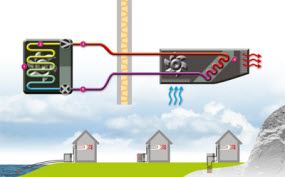It is based on the relationship between temperature and pressure in a gas or liquid circulating inside a pump (the working medium). If the pressure rises, so does the boiling point of the liquid.

|
The energy for a heat pump can come from water, the atmosphere, ventilation air, bedrock or the soil. |
Your fridge is like a “reverse heat pump” that transfers heat out of its interior to the cooling fins a the back. If we were to remove the door, set up the fridge outside the house, take off the cooling fins and put them indoors, and connect up all the parts again with the necessary pipe-work and electric power, we would have a heat pump.
Raises the temperature
The energy for a heat pump can come from water, the atmosphere, ventilation air, bedrock or the soil. However, energy is stored in all these sources at temperatures that are too low to be used directly.
By supplying the heat pump with electric power, we can produce an artificial pressure in the circuit that raises the temperature sufficiently to allow us to use it for heating purposes.
Energy drawn from the environment
Operating the pump takes one part electricity and two or three parts energy drawn from the environment; from these inputs, the heat pump delivers three to four parts useful heat.
The heat pump is something like a one-armed bandit that always pays out. When the thermometer is reading around zero, you insert a single coin and get back three in the form of heat. If the outdoor temperature is fifteen degrees below, the latest models of heat pump could give you back two.
Large energy savings
Energy scientists have estimated that from 75 to 90 percent of domestic heating requirements can be met by a heat pump, equivalent to savings of 40 to 60 percent of the total energy consumption of a house.
Useful adresses
Scientists at SINTEF Energy Research’s Dept. of Energy Processes are working on heat-pump technology.
In the field of heat pumps, SINTEF is involved in technology development – we are developing next-generation high-efficiency heat pumps – and in technology transfer.
